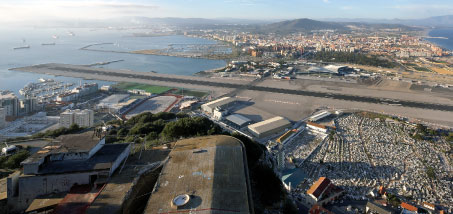
Due to a limited amount of flat land on the peninsula, GIB’s runway is bisected by the main artery of highway traffic that goes in and out of Gibraltar. Photograph: Hufton and Crow
The new Gibraltar Airport is located on the fringe of the British Overseas Territory’s border with Spain, and, just a stone’s throw away from the region’s tourist-attracting Rock, has a truly unique backdrop. At 19,600sqm, the new £85 million airport is a vast expansion on the previous 5,000sqm terminal, which in recent years had struggled to cope with the peninsula’s burgeoning number of visitors. With three departure gates, 16 check-in desks and upper and ground floor baggage reclaims, Gibraltar Airport is now in a position to receive the influx of travellers anticipated in the near future; it has the capacity to handle one million passengers and is currently experiencing throughput of around 400,000.
Arrivals shifted from the old to the new GIB terminal in November 2011, while it handled its first departure in September 2012. Soon it will enter its first fully-operational summer – when passenger traffic is expected to reach its highest yet – and Terence Lopez, Air Terminal Director, explained that the coming months will be all about perfecting airport operations, and capitalising on the opportunities that the new terminal presents.
“In a day-to-day sense what I’m concerned with is getting the terminal ship-shape,” stated Lopez. “In summer we will have an average of five flights a day – on Sunday that comes up to seven – and that for us is quite a big step, considering that at the moment we only have one or two flights on some days.”
In preparation for the busy season, Gibraltar Airport is continuing the modernisation of its new terminal, and is currently in the process of implementing new technologies throughout its departure area. Four self-service counters are soon to be installed, while in security an explosives detection system has been put in place. Also key to Lopez’s strategy is preparing his workforce. “I cannot lose sight of the fact that it is the people that work inside the airport that make it what it is, and however much you do with the architecture, the people working within it are its blood – the life and soul of it,” Lopez said. “You can have the most beautiful building in the world, but if the staff within it aren’t doing their jobs properly all the feedback you get from passengers will be negative. So that’s my emphasis now, getting our equipment and our staff ready for the passenger avalanche we’re going to start getting, so that when it happens – we’re ready for it.”
Expanding Gibraltar’s network
The airport’s increased capacity and size presents a wealth of opportunities to adopt new routes and services. Lopez explained that since the completion of the new airport building, expansion of GIB’s route network has been at the forefront of its plans for growth.
“The airport has a very active route development unit and it is constantly trying to attract new routes into Gibraltar,” Lopez commented. “The fact that the new terminal has opened has really given them the catalyst they needed to get things moving. We are looking at every kind of route at the moment. By the end of May we will be serving several destinations within the UK – London Heathrow, London Gatwick, London Luton and Manchester, with Birmingham coming online in March. The Government of Gibraltar is permanently trying to expand the route network, and not only to the United Kingdom – they want to fly to Ireland and, of course, the rest of Europe.”
A calming airport journey
“Even though we are quite a small airport we have one of the best views in the whole world. The terminal itself faces the North face of the Rock, and you can just sit there for hours and look at it,” Lopez said.
Indeed, the airport’s glass and steel structure is a unique and well-mediated design, customised to the region’s beauty. Fully glazed walls maximise the view of the Rock and across the straits towards Africa, the Atlantic and the Mediterranean. In departures, landside and airside viewing terraces look out across the active apron, enabling passengers to pass the time before their flight by taking in the scenery and enjoying the theatre of an operational airport.
The airport’s inventive shape was designed to reflect the terminal’s aviation function and maritime location, while the overhanging roof provides a high level of solar shading to maintain a cool airport environment and high-performance double glazing and automated roller blinds enable the building to be predominantly naturally lit, contributing to enhanced energy performance.
So far passenger feedback on the terminal has been very positive, with its transparent design having been recognised for enhancing the passenger experience by offering a calming journey through the airport.







